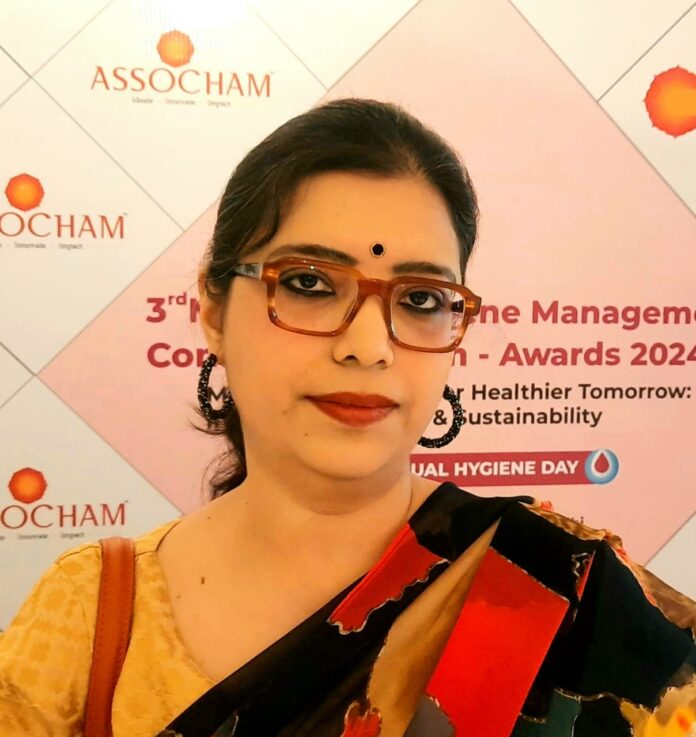Menstrual hygiene in India faces multifaceted challenges rooted in policy, accessibility, affordability, inclusion, and infrastructure. Despite policy efforts, inadequate implementation and awareness persist, limiting effective outreach. Geographical and socio-economic diversity hinder accessibility. The scarcity of menstrual products and proper sanitation facilities particularly affect rural areas. Affordability remains a significant barrier. Many women and girls cannot afford sanitary products, leading to the use of unsafe alternatives. Inclusion issues arise from cultural stigmas and taboos, perpetuating silence and misinformation about menstruation.
Additionally, infrastructure shortcomings, such as lack of clean toilets and disposal systems in schools and public places, exacerbate the problem. Addressing these challenges requires comprehensive policy frameworks, increased funding for menstrual health education, affordable product distribution, improved sanitation infrastructure, and efforts to dismantle societal taboos, ensuring a dignified and healthy menstrual experience for all.
In an exclusive exchange with The Interview World during the 3rd Menstrual Hygiene Management Conference-cum-Awards 2024, hosted by ASSOCHAM, Urvashi Prasad, Director of the Office of the Vice Chairman at NITI Aayog, underscored the pressing challenges surrounding menstrual hygiene in India. Transitioning smoothly, Prasad delved into crucial issues including awareness, infrastructure, accessibility, inclusion, and affordability. Moreover, she elaborated on the government’s proactive measures aimed at tackling these obstacles. Below encapsulates the pivotal highlights gleaned from her insightful discussion.
Q: What challenges exist in menstrual hygiene management in India, and what measures is the government taking to address these issues?
A: Numerous challenges abound, ranging from the loss of school days to decreased education, productivity, and health, all culminating in national economic setbacks. The government’s focus lies in enhancing accessibility, promoting health, and fostering a supportive environment for women. To achieve this, we are actively addressing gaps and disparities, particularly in rural, remote, tribal, and informal sector settings.
Institutional facilities must cater not only to women in the formal sector but also to those in the informal sector. Thus, addressing obvious issues such as these becomes imperative. Additionally, we are implementing sustainable, environmentally friendly, and sanitary solutions to tackle waste disposal, a significant concern.
While there has been a heightened policy and programmatic focus on this issue in recent years, we still grapple with deep-rooted social stigma. For instance, period huts persist in Maharashtra, perpetuating the segregation of women during menstruation. These enduring challenges demand our urgent attention and concerted efforts.
Q: What broad-level changes have been observed following the implementation of government initiatives?
A: Between the fourth and fifth rounds of the National Family Health Survey, we observed a notable 20-percentage point increase in the utilization of safe and hygienic menstrual products. Recent data highlights the effectiveness of interventions, particularly those driven by civil society, in raising awareness levels. The involvement of civil society is crucial, as governments alone cannot address this issue comprehensively. It’s fitting that our gathering includes not only government representatives but also members of civil society and industry, recognizing the magnitude of this challenge necessitating a collaborative approach.
Undoubtedly, awareness levels and access to menstrual products have improved, yet significant gaps persist, which demand our attention. These gaps extend beyond mere access; they encompass substantial inequalities, both geographical and within states. While much focus is often placed on central government policies, numerous states have undertaken commendable initiatives in menstrual hygiene. Bihar, for instance, stands as a pioneering state with a longstanding menstrual health policy, a precedent also set by Kerala. However, such examples remain few and far between. We require a proliferation of similar initiatives across states. Tailoring to local contexts, we can ensure widespread acknowledgment and action at the state level.
Q: What specific outcomes or changes do you expect from policy-level initiatives?
A: Looking ahead to our objectives and policy agenda, it’s crucial to emphasize inclusivity in menstrual hygiene. This perspective is central to my current stance. We must ensure that our efforts address the diverse menstrual needs of all individuals, including those with disabilities, transgender men, and people with various gender identities who menstruate.
It’s imperative that our approach is inclusive and accommodating to all these groups. Tailoring solutions to meet the specific needs of each demographic is paramount, as there’s no universal solution that fits everyone. Additionally, we must address the environmental implications of menstrual waste and disposal.
Transitioning to a broader perspective, our commitment to achieving high-level goals such as net zero emissions and environmental sustainability is crucial. As we strive for growth and development, we must prioritize environmental stewardship. This entails moving towards carbon neutrality and adopting practices that minimize our ecological footprint.
Q: What strategies can be implemented to improve accessibility and affordability for women from diverse financial backgrounds?
A: Considering these factors, it becomes clear that every sector, including our own, experiences significant impacts. It is imperative, therefore, to prioritize sustainability and environmental friendliness alongside affordability and accessibility. This necessitates fostering innovation within our industry to advance technologies and enhance the eco-friendliness of our products. By doing so, we can address pressing global challenges while also meeting the needs of consumers and the environment.
The industry stands as a pivotal player in driving progress in these crucial areas. Through concerted efforts and investments in research and development, we can not only stay ahead of the curve but also set new standards for sustainable practices. In doing this, we not only benefit our businesses but also contribute positively to the world we live in and improve menstrual hygiene.
Q: What strategies and interventions can be implemented to improve the infrastructure necessary for adequate menstrual hygiene management?
A: Our current infrastructure, fortified by initiatives such as Swachh Bharat, has undoubtedly made commendable progress in extending basic amenities to households, schools, and institutions. However, I vehemently advocate for the essentiality of continual maintenance—a viewpoint deeply rooted in my extensive background in public health, particularly within urban slums where my focus has been on sanitation projects.
It’s crucial to recognize that the mere provision of toilets represents only the initial step; effective waste disposal remains a pressing concern. These multifaceted challenges, encompassing sanitation infrastructure, behavioral transformations, and menstrual health awareness, necessitate sustained investment and unwavering commitment to menstrual hygiene management.
In the realm of policymaking, we’re tirelessly championing the cause of continuity, acknowledging these endeavors as inherently enduring and ongoing. We understand that these initiatives require long-term dedication and resources, extending far beyond initial implementation. Therefore, it’s imperative that all stakeholders maintain their dedication to investing in these endeavors, recognizing their intrinsic importance and prolonged impact on public health and societal well-being. Only through collective and steadfast commitment can we truly address these persistent challenges in menstrual hygiene and pave the way for a healthier, more hygienic future for all.



